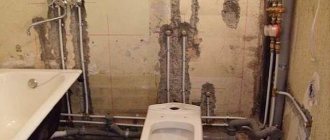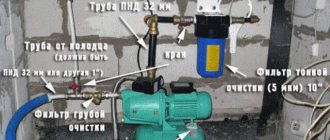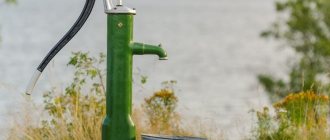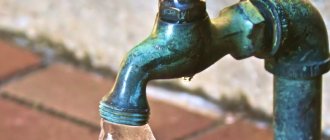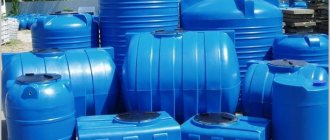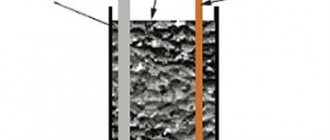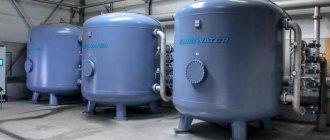In this article we will look at a diagram for installing water supply pipes in any private house with our own hands. It is quite difficult for a person without special training to understand the intricacies of arrangement, but we recommend that every home owner understand the basics. This will be useful for monitoring the work of installers, as well as for choosing the optimal supply option. Laying a pipeline is no less significant a task than organizing a network of pumping equipment. We will provide all the necessary information to make it easier to understand the specifics of the device and the rules, in addition, everything is based on regulatory requirements.
Types of water supply wiring in a private residential building according to the drawing
There are 2 main types of water supply, which is carried out in households:
- autonomous - everything comes from a personal well or a drilled well;
- centrally - supply from a special line that takes resources from a tower or a station designated for this.
Both methods have their positive and negative sides; you should decide on the subspecies before starting installation, because each of them has its own characteristics. The final cost of the entire process also depends on the choice. Although there are situations when only one of the methods is possible (for example, in the absence of a centralized water supply system) and then there is no choice.
Scheme of input and connection of water supply (water) of a residential private house from the central water supply
When choosing a system, you should think about several criteria:
- is there a water main in the area? It’s funny, but people sometimes forget to take this into account;
- what quality of moisture is supplied - it happens that it is only technical, it is not recommended to drink;
- how reliably and uninterruptedly does the supply function? In some regions there is pressure only by the hour or on days of the week;
- does it depend on external factors - some lines stop working in winter;
- how expensive it is - sometimes it is much cheaper to drill your own well than to crash into a working highway.
How to distribute water around the house if there is an autonomous water supply
When an owner wants to equip his personal well, he should prepare for large labor and financial costs even at the construction stage. First you will have to dig a well or drill it, draw up the correct technical plan, select and buy equipment. Only then will you need to mount and connect.
If you do not focus on the price of this choice, then it has many advantages:
- you don’t have to depend on any external factors;
- can be carried out everywhere, it is especially convenient where there is no common highway;
- no need to pay monthly;
- The quality of moisture is usually much higher, in addition, you can install any filters if necessary.
If it turns out that the source is not clean enough and drinking from it is not recommended, then special treatment facilities can be installed. This will greatly clean and improve the condition of the liquid, making it suitable for cooking and drinking. Choose such a device on our website, and if you have any questions, the managers will be happy to answer them.
Pumping station
If the water supply to a private home is from a well or borehole, then an indispensable attribute of such systems is a pumping station or pressure tank. Since the tank must be installed in the attic, and this requires quite a lot of effort, pumping stations are in greatest demand among homeowners.
This system perfectly performs the functions of transporting water both from the well and from the well, so its scope is quite wide. Particular attention should be paid to the fact that such mechanisms are quite sensitive to low temperatures. Thus, they must be installed in heated rooms, for example, on the basement or living floors.
When choosing a location for installing the pump, keep in mind that it makes noise during operation. If you plan to place the pump on a residential floor, it is recommended to allocate a separate small room or storage room for it.
When building a water supply system with your own hands, in particular installing a pumping station, take into account the fact that a check valve must be installed in the area from the water source to the station. It is installed to ensure the necessary conditions so that water from the pipeline does not return back to the well in the event of a regulator failure. It is recommended to install a filter in front of it for additional cleaning. Also, the pipelines that surround the pumping station must have shut-off elements on both sides. They are necessary for carrying out repair work.
The pumping station is installed using fittings. For this, two threads are used, which are located on the system body (at the inlet and outlet).
Note! Some models of pumping stations have a pressure switch and a damper tank in their design. These are compact devices with low productivity, which will be quite enough for 1-2 storey cottages. If we are talking about a large private house - for 2 or more families, the installation of more powerful pumping stations will be required. High-performance models are available in separate forms, i.e. the pump, relay and tank are located separately. Installing pumping stations of this type is a more complex process.
Pumping station
Photo of the installation diagram for a water supply system, which is usually used in a private country house
There are 2 ways in which the connection can be made - in series, one after the other, and in parallel, when everyone is turned on at the same time. What to do at home depends on how many people live, whether they are there permanently or periodically, and how intensively the water supply is used.
In some cases, a mixed type is used, when all mixers are connected through a manifold-combiner, and all other elements must be connected in series.
If the connection is serial
It looks like alternately supplying pipes that lead from the riser or water heating device to the plumbing and taps. First, general ones are diverted, and then branches go from them through tees to the places where moisture will be consumed.
This is a more economical method; it is often used in apartments and small houses. The essence of saving is in a small amount of materials, and the installation itself is simplified. The system will be compact, it will be easier to hide it under the decoration.
A serious drawback is that if several people use hot liquid at the same time, then at the most distant point the pressure will be significantly lower than at others.
Another disadvantage is that if you need to repair or connect any of the plumbing fixtures, you will need to disconnect the entire housing from the supply.
This is why we recommend using a different scheme in private homes with high consumption to avoid problems with operation.
If the connection occurs in parallel
This option is based on the fact that the pipes themselves go from the main collector to the points where water intake will occur. Separate nodes are placed for each line.
It will be necessary to lay a lot more pipe lines, which means that it will be difficult to camouflage them. And any part with a tap or appliance will have a stable, unchanging pressure, even if several plumbing fixtures and taps are used at the same time. Changes in pressure will be minimal, the pressure will be even.
A collector is a device that has one input and two or more outputs. Their number will depend on how many nodes and equipment the source uses.
MBFT-75 Membrane for 75GPD
SF-mix Clack up to 0.8 m3/h
SF-mix Runxin up to 0.8 m3/h
For cold water supply this is done before entering the premises, and for hot water supply - immediately after the water heating product. A cleaning filter and a reducer are installed in front of the collector, which will control the pressure.
How to create a project yourself?
In order to properly plan the plumbing system, you must first draw up a house plan, placing in it all the plumbing fixtures and equipment that will be connected to the water supply.
All dimensions are indicated on the same scale, according to actual measurements of the premises. The more accurately the plan is drawn up, the more accurately it will be possible to determine the required amount of materials and components.
The water supply diagram should reflect as accurately as possible all water intake points, the length and location of pipes for transporting water, and even sewerage, since these communications are often located nearby. The number of filters, boiler volume, and pumping equipment parameters are also taken into account.
The wiring diagram must be simplified as much as possible, trying to avoid crossing pipes. Water pipes are located closer to sewer pipes in order to hide them with a common duct. When placing pipes under the floor, the outlet of the tees is positioned straight up
The project must take into account the requirements of building regulations, as well as the rules of water supply and sanitation approved and in force in the country.
If the water supply is external, where is the housing supplied from?
There are several schemes for distributing water in every private house without do-it-yourselfers, let's look at them in more detail.
Central water supply
The most budget-friendly way to organize water indoors. To cut in, you need to get permission from the settlement administration, then install meters, install equipment, and lay a pipeline to your home. Another condition is the installation of a septic tank or other wastewater treatment facility.
Well
One of the most common mining methods in suburban areas and in the country. Typically used where the liquid is shallow. The main advantage is that even if there is no light or pump, you can still fill a bucket, even with a lot of effort.
Well
The purest liquid of all the options proposed above. There is more of it, you can simultaneously provide several areas at once. But creation requires significant investment, and a license for use will also be required.
Types of water supply sources
First you need to decide which source of water supply for a private home is best suited for your case. Before choosing a system, you need to understand that the water consumption rate per person is 200 liters per day. This figure was not taken out of thin air, but from regulatory documentation - SNiP 2.04.01-85 * “Internal water supply and sewerage of buildings.”
Please note that if you have a vegetable garden or green spaces, then the consumption rate should be even higher. For these purposes, it is recommended to take into account at least 5 liters of water per square meter of land area.
If we take as an example an average family of two adults and children who live in a house with flower plants and flower beds measuring 20 m2, the following formula is obtained: V = 4 people × 200 liters + 5 liters × 20 m2 = 800 l + 100 l = 900 liters per day.
As you can see, the estimated water consumption for a home is quite high, so the choice of source for the water supply system must be well reasoned. Otherwise, problems with water supply may occur.
Currently, there are only two options for such systems available to us: main water pipelines or private water sources. We will talk about them in more detail below.
Connection to the main water supply
This option can also be called stationary - it is simple in terms of technical measures, which is why it is in greatest demand among homeowners. The water supply system is designed in such a way that its basis is the main pipe. Branches go from it and distribution networks are laid, from which, in turn, intra-block networks are formed. The last sections are where the consumer facilities are connected. The documentation that regulates all these activities is SNiP 2.04.02-84* “Water supply, external networks and structures.”
In order to use this method, the property owner must contact a company that provides network maintenance. After reviewing the request, she makes a decision about the possibility of connection in your particular case. If the answer is positive, all necessary documents are drawn up and a permit is issued. It indicates the connection conditions, as well as the recommended water supply scheme. After this, the owner has the right to lay the necessary communications to connect to the network. This can be done on your own or with the help of contractors.
Main water supply
Autonomous water supply
Autonomous water supply is considered the most optimal option for people who do not have the opportunity to connect to the main water supply. For example, in country houses where there are no communications nearby. Water can be used from a well, river, well and other sources. Remember that the distance of the water source from the septic tank and cesspool must be at least 20 meters. This is a necessary condition for safety reasons so that wastewater does not get into drinking water.
Experts advise drilling a well or digging a well near the house so that the costs of excavation work and pipeline installation can be minimized. Before starting work, you must make sure that water will flow in sufficient quantity.
If we are talking about a house where you live permanently, the ideal option would be to install a well for drinking water and a well for technical water, which will be used for watering the garden.
Types of wells
There are only 2 main subspecies. In the first case, you can drill an artesian, which has a depth of up to 150 meters, or a regular one, “into the sand.” The second one does not go deeper than 15-50 meters.
They also differ in the time they can be used. The former last up to 50 years, and the latter usually no more than 20 years.
Which pump to choose
In order for water to flow from the tap, you need to install pumping equipment that will cope with the task.
The main thing is to take into account several parameters:
- how much liquid will be consumed;
- where is the highest point of consumption;
- what performance is needed;
- how deep is the well;
- average pressure (will be written in the passport).
We recommend using a voltage stabilizer when connecting such equipment.
Wiring diagram
The choice of pipe parameters depends on the type of water supply network. With a series (tee) connection, all water intake points are installed one after another. Due to the small number of key parts, the method allows saving costs on materials.
When turned on at the same time, due to weak pressure, little fluid will flow to the remote component. To neutralize the problem, you need to choose the correct pipe diameter. It is recommended to take elements whose parameters are one step smaller than the main system. The technique helps to increase the pressure in diversion structures.
Tee pipe routing Source posudachimodache.ru
The collector wiring diagram allows you to connect several water intake points in parallel to a source or main line. For each device, an individual line with a valve is assembled. The pressure remains stable during simultaneous operation.
When choosing the diameter of the pipes, they are based on the length of the parts and the characteristics of the pipeline. Installing a collector circuit consumes more materials. The throughput of a properly designed water supply system is not dependent on the number of bends and connected devices.
Collector wiring diagram Source myosu.ru
Scheme for introducing a water supply system into any private house, where to start drawing up a water supply project
All installation activities should begin with the project. Already at this moment it is worth thinking about what type will be built, how often it will be used and approximately how many drainage points will be required. This is important because the parameters will determine what system and equipment needs to be supplied.
Options:
- submersible pump with automation;
- pumping station;
- hydraulic accumulators.
What to consider when designing a connection diagram and introducing cold water in a private house (with photo)
Equally important are the ways in which the liquid will be filtered. The easiest way is to find out the quality and install the appropriate filter or the whole system.
You should also think in advance about how the hot pressure will be supplied and at what depth the products should be laid - each region has its own options.
Expert advice
During the installation of a water supply system, various questions arise related to the features of this system. Therefore, experts offer some tips to help installers make their work easier:
- When laying pipes through walls, it is better to use special gaskets. This will protect the pipes from abrasion and damage;
- more threaded connections should be used;
- When installing drain taps, you need to make a slight slope towards the tap. This will make it possible to prevent water from accumulating after draining;
- Excessive bending of pipes should not be allowed, as they reduce the water pressure in the system;
- use the same fasteners, fittings and splitters throughout the water supply so that they can be replaced with the same products;
- You should definitely have a supply of fasteners and fittings, as well as taps, tees, fum tape and gaskets;
- The system must have shut-off valves to quickly shut off the system in the event of an emergency.
The nuances with which DHW is supplied
Typically, electric or gas boilers, water heaters or boilers are purchased for this purpose. The equipment can operate on solid, liquid fuel or gas. Each option has its own advantages and disadvantages; it is worth focusing on what is most often chosen in the region.
Different fluid supply principles
You can install cold and hot water supply using one of 2 methods, which we will discuss below.
SF-mix manual up to 0.8 m3/h
AMETHYST - 02 M up to 2 cubic meters/day.
Aeration unit AS-1054 VO-90
"Blind" wiring
A dead end is installed at the last water intake mark - the liquid does not flow further. This is economical in terms of finances and space. At the extreme node, water will appear with a delay, and will flow into the tap only after it touches the plug.
Circulating closed system
The moisture here moves in circles all the time at the same temperature. The user will receive it immediately. This is best used for hot water supply to avoid serious temperature changes. Combined techniques can be used.
Products on the market
The catalogs of accessories for collector water supply systems provide a wide variety of not only combs, but also their components.
- Dividers without taps are much cheaper. They allow you to assemble a device that will best suit the object. This option is preferable, as it allows you to easily replace only the failed faucet. While the one-piece design will require complete replacement.
- Devices with shut-off valves greatly simplify the installation of a water supply collector. They simplify the assembly of the unit - there is no need to install taps.
- Accessories allow you to adapt the system according to your wishes: valves, pump groups, plugs, valves, brackets, couplings, ends, servos, fittings.
- Manifold cabinets are sold separately, which are mounted into the wall and provide an aesthetic appearance, as well as access to the engineering unit.
What kind of pipes can be used to lead through the premises?
Another popular question is what material the line is made of. It all depends on several factors:
- what type of wiring is used;
- will DHW be required?
- budget;
- type of installation - hidden or open.
Polypropylene
Usually used with a tee system. Cross section – 20-25 mm. A larger diameter is preferable if there are 3 or more nodes. 25 mm can pass up to 30 liters per minute.
Peculiarities:
- are not afraid of corrosion;
- inexpensive;
- cut with any tool;
- lungs;
- tolerate defrosting up to 4 times;
- do not bend;
- It is necessary to have the skill of soldering sections.
Metal-plastic
Another very popular option. Usually used if the wiring is collector. Section – 16 mm. When choosing, pay attention to the thickness of the aluminum layer; it should be in the range from 0.3 to 0.55 mm.
Main table dispenser AquaPro 919H/RO (hot and cold water)
Main table dispenser AquaPro 929CH/RO (cooling/heating)
Floor dispenser AquaPro 311 (empty, without cooling)
Nuances:
- durable;
- are not afraid of corrosion;
- used up to 100 years;
- can bend;
- more expensive than polypropylene;
- uneven;
- if installed incorrectly, there will be leaks;
- do not tolerate defrosting.
Cross-linked polyethylene
Usually they are placed on a warm floor, but sometimes this acts as an alternative to metal-plastic.
Peculiarities:
- flexible;
- lungs;
- do not react to corrosion;
- wear-resistant;
- withstand changes in pressure and temperature;
- easy to install;
- expensive;
- not suitable for open types of wiring.
Metal or steel
Previously they were made from them, then they switched to PP or metal-plastic. They should not be used for plumbing because:
- suffer from corrosion;
- difficult to transport and install;
- more expensive than plastic;
- connection requires a welder and equipment;
- growths gradually appear inside;
- high thermal conductivity.
Copper
Usually they are not installed in houses. It is not afraid of corrosion, but it is very expensive and difficult to install; special equipment will be required for welding. High thermal conductivity - hot things cool down quickly, and cold things heat up.
Stainless steel corrugation
This is also not a cheap option. For example, you can pay three times less for PP. But it is used because the quality is high and the service life is quite long.
Nuances:
- keeps its shape;
- bends;
- not afraid of corrosion;
- no welding machine required.
Ready-made systems for plumbing
Some manufacturers offer pipe kits that can then be used for manifold wiring.
The advantages of this choice:
- quality and reliability;
- energy efficiency;
- simplicity and speed of installation.
Laying methods - hidden and open system
Pipes in the water supply system can be laid in closed or open ways. The choice of one of the methods does not affect the quality of the connections or the functionality of the entire system and depends only on personal preferences.
It would seem that it is not difficult to decide and the closed method is preferable as it is more aesthetic and allows saving up to 10 cm of usable space. Why is an open pipeline still used when installing a water supply system? Let's try to give an answer.
Image gallery
Photo from
Water supply made of metal-plastic pipes
Polypropylene water supply system
Water supply system using VGP pipes
Water pipes made of copper and stainless steel
Hidden wiring allows you to hide pipes and not spoil the aesthetic perception of the interior of a house or apartment. The hidden method is used when assembling a water supply system from PP pipes. They hide the contour behind a decorative wall, for example, made of plasterboard, or they groove the walls and insert pipes into the resulting niches, sealing them with facing material or plaster over a mesh.
The pipeline should not be tightly adjacent to the surfaces - always leave a small gap for possible repairs. When installing a pipeline into a monolith, it is recommended to place them in a casing, inserting the pipe into the pipe.
The disadvantage of the method appears when there is a need to repair or replace hidden elements of the system - the plaster or tiling has to be opened and then re-decorated.
In addition, in the event of damage and leaks, the problem may not be detected immediately and lead first to a loss of operational technical characteristics of the structures, then to flooding of the premises.
It is better to start installing a water supply system with a pre-drawn diagram - otherwise errors in calculations or assembly will lead to the need to cut new grooves and re-install the pipes
To avoid such difficulties, when installing the wiring, only whole sections of the pipe are hidden, placing connecting fittings in open areas. Inconspicuous doors are made in places where shut-off valves are installed. This gives access during maintenance to pipe connections, which are the weakest links in the system.
It should also be noted that pipes made of not all materials can be hidden under a layer of plaster - only products made of polypropylene, metal-plastic or copper are suitable for this.
Open pipe laying is carried out after finishing is completed. The method involves the uncovered laying of pipes and water supply elements. It looks ugly and reduces the usable area of the room, but at the same time this method is very convenient for maintenance, repair and dismantling of elements.
Redevelopment and rearrangement of plumbing in the house with such a plumbing arrangement will also not cause difficulties.
Open wiring makes it possible to quickly detect the location of a leak and eliminate the cause of breakdown or damage to system elements
